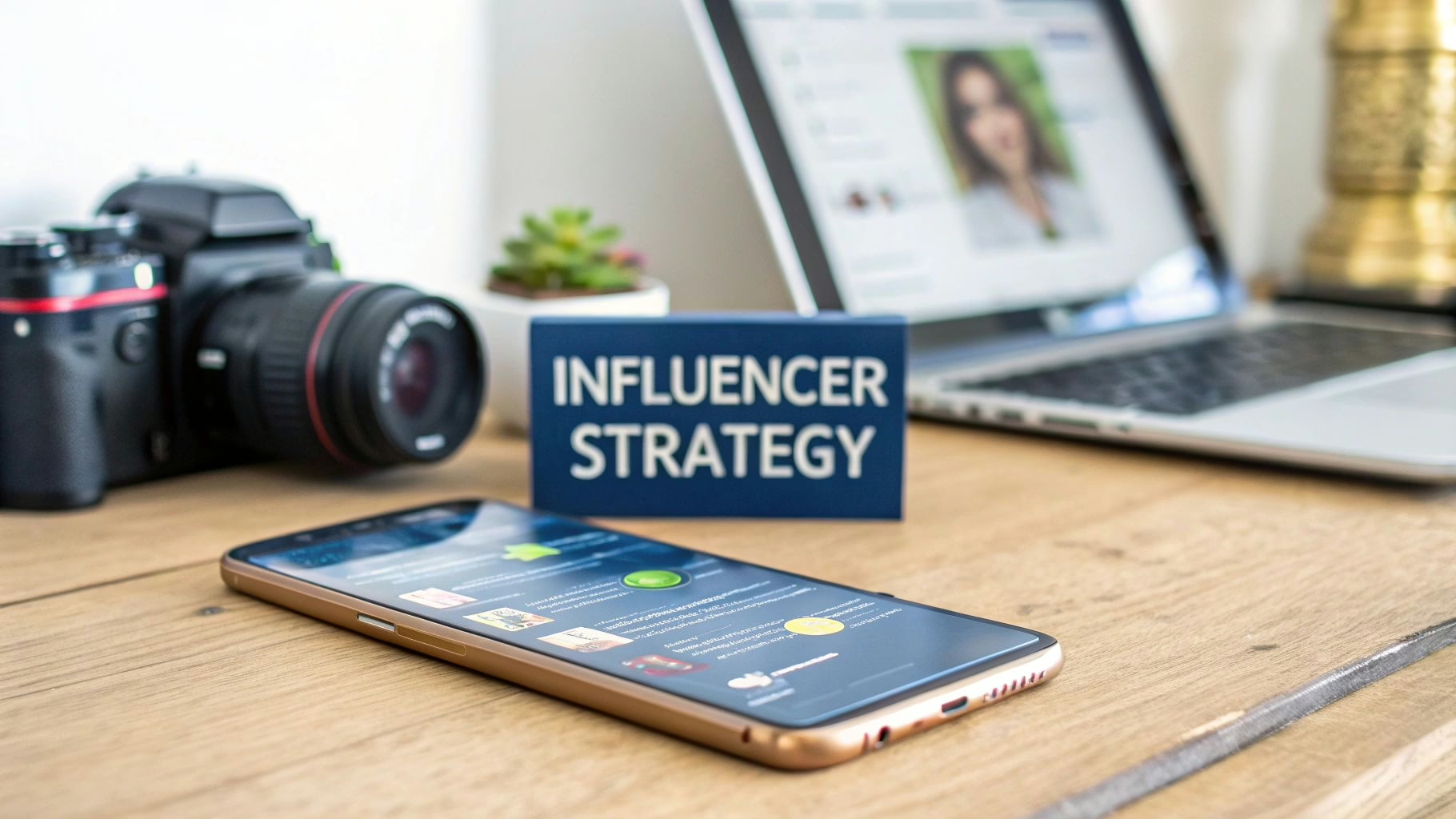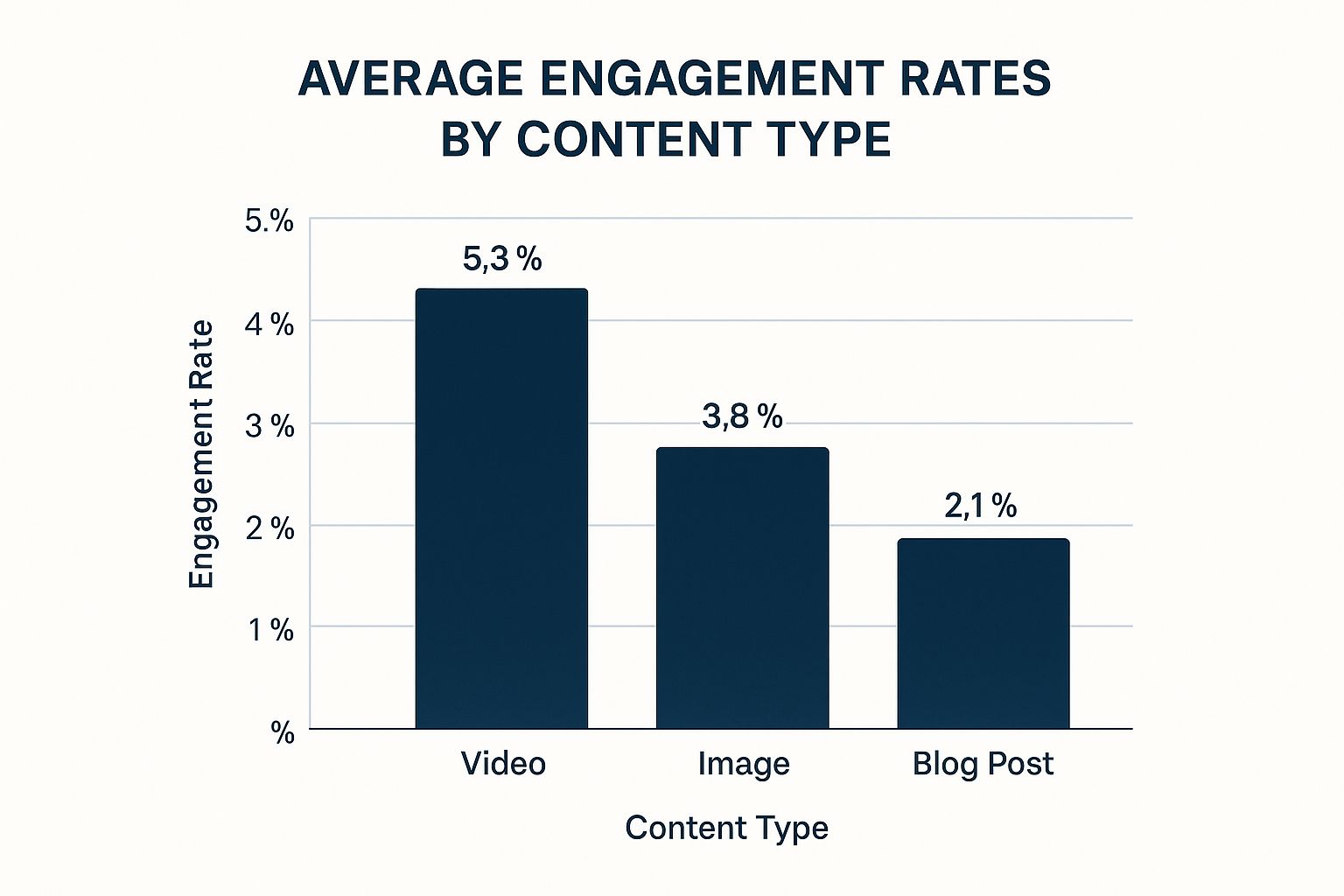The Evolution of Influencer Marketing
Influencer marketing has changed dramatically. It’s no longer just about celebrity endorsements. Instead, it’s a core strategy for businesses looking to connect authentically with their audiences. This change comes from a shift in consumer behavior: less trust in traditional advertising and more trust in online personalities and creators. Brands must adapt their influencer strategies to connect with this new consumer.
From Celebrity Endorsements to Creator Partnerships
Influencer marketing initially relied on celebrities. These figures lent their fame to products, hoping their recognition would drive sales. However, this approach often lacked authenticity. Consumers saw through the often-forced partnerships, realizing celebrities might not actually use or believe in the products. This led to the rise of creator partnerships, where brands work with individuals who’ve built a dedicated following based on shared interests and values. For example, a fitness apparel brand might partner with a yoga instructor who genuinely uses and likes their products.
The Power of Authenticity and Trust
This evolution highlights how important authenticity is in modern influencer marketing. Consumers connect more with content from creators they see as genuine and relatable. These creators have built trust in their communities, making their recommendations more effective than generic ads. The rise of social media platforms like Instagram and TikTok gave creators new ways to connect directly with their audience, building stronger relationships and brand loyalty. The global influencer marketing industry has boomed, becoming a key strategy for brands. In 2020, the market was worth almost $10 billion, and it’s projected to reach about $32.55 billion by 2025. This growth is driven by increasing consumer trust in influencers over traditional advertising. You can find more statistics here: https://www.statista.com/topics/2496/influence-marketing/
Adapting to the Creator-Driven Economy
Today’s influencer marketing needs a more strategic approach. Brands are moving away from transactional relationships and towards long-term partnerships with creators. This means understanding the nuances of different platforms and tailoring campaigns to specific audiences. Measuring success also requires a shift beyond follower count. Brands now prioritize metrics like engagement, website traffic, and conversions to show the real return on investment (ROI) of their influencer marketing. This shift to meaningful collaboration has created a creator-driven economy, where individuals with online influence significantly shape consumer behavior and drive brand growth.
Building Your Influencer Strategy Framework That Works
A successful influencer marketing strategy needs more than just launching random campaigns. It requires a well-defined, structured framework. This framework ensures your influencer partnerships align with your broader marketing objectives. It also helps create scalable processes and measure the metrics that truly matter to your business. In essence, it’s about building a system that can adapt and grow alongside your brand.
Defining Your Objectives and KPIs
The first step is defining your campaign objectives. Ask yourself what you want to achieve through influencer marketing. Is it increased brand awareness, driving more website traffic, or boosting sales? Each objective requires specific Key Performance Indicators (KPIs).
For instance, if brand awareness is your goal, you’ll likely track reach, impressions, and social media mentions. If sales are your focus, you’ll monitor conversions, click-through rates, and revenue generated. Clearly defining these metrics from the start is crucial for accurately evaluating campaign success.
Identifying Your Target Audience
Understanding your audience is paramount to an effective influencer marketing strategy. Consider which social media platforms they frequent, the type of content they engage with, and the online influencers they already follow and trust.
Answering these questions helps pinpoint the right influencers to partner with—those whose audience aligns with your target demographic. This ensures your message reaches the individuals most likely to convert into customers. For valuable insights into audience targeting and campaign development, exploring current influencer marketing strategies can be beneficial.
Selecting the Right Influencers
Choosing the right influencers involves more than just looking at follower counts. Authenticity and audience engagement are key factors. Prioritize creators who genuinely align with your brand values and produce high-quality content that resonates with their followers.
Dive deeper into selecting authentic brand representatives with our guide on How to master influencer marketing with real-world examples. Also, consider the various tiers of influencers, from nano-influencers with smaller, highly engaged communities to mega-influencers with extensive reach. Each tier offers distinct advantages depending on your specific campaign goals and budget.
Building Long-Term Relationships
Influencer marketing thrives on lasting relationships. Treat influencers as collaborative partners, not merely paid promoters. Offer them creative freedom, involve them in campaign development, and provide fair compensation.
This collaborative approach fosters trust and results in more authentic, engaging content. Furthermore, long-term partnerships enable ongoing storytelling and deeper connections with your target audience.
To better understand the essential components of a robust influencer marketing strategy, let’s examine the table below:
Influencer Marketing Framework Components
A breakdown of the essential elements needed in a comprehensive influencer marketing strategy
| Framework Component | Purpose | Implementation Considerations |
|---|---|---|
| Defining Objectives & KPIs | Establish clear goals and measurable metrics for campaign success. | Align KPIs with specific objectives (e.g., brand awareness, sales). |
| Identifying Target Audience | Determine the demographics, interests, and online behavior of your ideal customer. | Research audience preferences and social media platform usage. |
| Selecting Influencers | Choose influencers who align with your brand values and resonate with your target audience. | Consider authenticity, engagement, and influencer tier. |
| Building Long-Term Relationships | Foster strong, collaborative partnerships with influencers. | Offer creative freedom, involve influencers in campaign development, and provide fair compensation. |
This table highlights the interconnectedness of each component within the framework. From defining clear objectives to nurturing long-term relationships, each element plays a vital role in building a successful influencer marketing strategy. By focusing on these core components, brands can maximize their impact and achieve their desired outcomes.
Finding Partners Who Truly Represent Your Brand
Finding the right influencers for your brand involves more than just checking follower counts. It’s about finding creators who truly align with your brand values, resonate with your target audience, and have the potential for long-term partnerships. This approach ensures authentic content that drives real engagement and contributes to your overall marketing goals.
Looking Beyond Surface Metrics
While follower count can be a helpful initial indicator, relying solely on this metric can be misleading. Authenticity and audience quality are much more important. A creator with a smaller, highly engaged audience can often deliver better results than someone with millions of passive followers. For example, a nano-influencer with a dedicated following of gardening enthusiasts will likely be more effective for a plant-based food brand than a celebrity chef with a broad but less targeted audience. You might be interested in: How to choose the right influencer.
This means carefully examining engagement rates, audience demographics, and the overall tone and style of the creator’s content. Do their values match yours? Does their audience align with your target demographic? Asking these questions helps ensure a strong fit that fosters genuine and impactful collaborations.
Evaluating Creator Authenticity and Audience Quality
Evaluating authenticity requires a thoughtful approach. Look for creators who demonstrate genuine passion for their area of expertise and consistently create high-quality content. Check for signs of organic engagement, such as meaningful comments and interactions from their followers. Avoid creators with suspiciously high follower counts or engagement rates, which can suggest fake followers or bot activity.
In addition, research the creator’s past partnerships. Have they worked with brands that share your values? Have their previous campaigns been successful? This due diligence can ultimately save you valuable time and resources.
The Power of Different Influencer Tiers
Different influencer tiers offer unique advantages. Nano-influencers and micro-influencers, with their smaller, highly engaged communities, excel at building trust and driving conversions within niche markets. Macro-influencers and mega-influencers (celebrities) offer a wider reach and can substantially increase brand awareness. Selecting the right tier depends on your specific campaign objectives and budget.
To help illustrate the differences between influencer tiers, let’s look at the following comparison table:
Influencer Tier Comparison: Comparison of different influencer categories by follower count, engagement rates, cost, and optimal use cases.
| Influencer Type | Follower Range | Typical Engagement Rate | Average Cost | Best For |
|---|---|---|---|---|
| Nano-Influencer | 1,000 – 10,000 | 5% – 10% | $10 – $100 per post | Niche product promotion, building community trust |
| Micro-Influencer | 10,000 – 100,000 | 2% – 5% | $100 – $1,000 per post | Targeted campaigns, product launches |
| Macro-Influencer | 100,000 – 1,000,000 | 1% – 2% | $1,000 – $10,000+ per post | Large-scale brand awareness, reaching a broad audience |
| Mega-Influencer (Celebrity) | 1,000,000+ | <1% | $10,000+ per post | Maximum reach, widespread brand recognition |
This table summarizes the key characteristics of each influencer tier, highlighting the relationship between follower count, engagement rate, and cost. Nano-influencers, while having the smallest reach, offer the highest engagement rates at the most affordable cost. Conversely, mega-influencers provide the greatest reach but at a significantly higher price point and with lower engagement rates.
The infographic above visualizes average engagement rates by content type. Video content boasts the highest engagement at 5.3%, followed by image posts at 3.8%, and blog posts at 2.1%. This data indicates that video content resonates most strongly with audiences, making it a powerful tool in influencer marketing. Understanding these nuances allows for strategic content planning and maximizes campaign impact across various platforms. Choosing the right content type and influencer tier is crucial for campaign success. Building strong relationships with creators who truly embody your brand leads to authentic content, greater engagement, and ultimately, a more effective influencer marketing strategy.
Maximizing ROI Through Strategic Budget Allocation
Planning your influencer marketing budget effectively is essential for a strong return on investment. This involves understanding your goals, market position, and the various ways to compensate influencers. Simply spending money without a strategy won’t bring success.
Setting a Realistic Budget Based on Your Goals
Align your budget with your campaign objectives. Are you aiming for broad brand awareness or focused conversions? Large-scale awareness campaigns typically require more investment than smaller, targeted sales campaigns. Your current market position matters too. Startups may allocate a larger portion of their marketing budget to influencer marketing than established brands with multiple marketing channels.
Understanding different compensation models is also key. Flat fees are standard, but performance-based incentives can link influencer efforts directly to results. This could involve bonuses for reaching targets like conversions or engagement levels.
Marketers increasingly see the value of influencer marketing, with over 80% confirming its effectiveness. This confidence fuels budget growth, with projected spending reaching $9.29 billion in 2025. More detailed statistics are available at: Influencer Marketing Hub
Exploring Different Compensation Models
Beyond flat fees, explore options like equity partnerships, offering influencers a stake in your company for their promotion. This can be attractive for long-term collaborations, aligning their success with yours. Value exchange is another alternative, providing free products, exclusive event access, or other non-monetary benefits for content. This can be cost-effective for smaller brands or when working with nano-influencers.
Consider tiered pricing based on influencer tiers. Nano-influencers generally charge less than mega-influencers due to reach and audience size differences. Negotiating rates and exploring various compensation structures helps you maximize your budget’s impact.
Measuring and Attributing ROI
Using proper attribution models is crucial for tracking your campaigns’ effects. This involves monitoring the customer journey, from initial awareness through conversion and even loyalty. Trackable links and promo codes help measure conversions, while website traffic and social media mentions provide insights into brand awareness and engagement.
For further reading, check out: How to Track Influencer ROI. By accurately measuring ROI, you can demonstrate the value of influencer marketing, justify your budget, and inform future campaign decisions. This allows you to optimize your strategy over time. Balancing short-term wins with long-term brand building is crucial for sustained success.
Crafting Briefs That Inspire Authentic Content
The success of your influencer marketing strategy depends heavily on the quality of your briefs. A well-crafted brief can inspire creative and authentic content. A poorly constructed brief, however, can stifle creativity and lead to disappointing results. This section explores creating briefs that empower influencers to produce their best work while aligning with your brand’s objectives.
Balancing Brand Requirements and Creative Freedom
Many brands make the mistake of creating overly restrictive briefs. While clear guidelines and brand messaging are essential, allowing influencers room for creative expression is equally important. Think of it as providing an artist with a color palette and a general theme, but allowing them the freedom to express their unique style within those parameters. Overly prescriptive briefs can stifle an influencer’s authentic voice, resulting in content that feels forced and doesn’t resonate with their audience. This can negatively impact campaign performance, as audiences connect with content that feels genuine and relatable.
The Psychology of Effective Creative Direction
Effective creative direction involves understanding the influencer’s strengths and giving them opportunities to showcase those strengths. Engage them in the briefing process. Ask about the type of content they excel at creating and what resonates most with their audience. This collaborative approach builds a strong partnership and empowers influencers to produce content aligned with their style and audience expectations. This ultimately leads to more organic and impactful results. Much like a conductor guides an orchestra, a well-crafted brief should guide the influencer without restricting their individual talent.
Building a Collaborative Briefing Process
Two-way communication is at the heart of a successful briefing process. Begin with a clear outline of your campaign goals, target audience, and key messaging. Then, encourage open discussion. Invite influencers to share their ideas, provide feedback on the proposed approach, and suggest different content formats. This collaboration not only strengthens the partnership but also fosters more innovative and engaging content. This is particularly valuable when working with experienced creators who have a deep understanding of their audience.
Practical Frameworks and Templates
Developing a practical framework for your briefs ensures consistency and clarity across all campaigns. Consider using templates for various campaign types, like product reviews, sponsored posts, or social media contests. These templates should include sections for campaign objectives, target audience, key messaging, content format guidelines, deliverables, timeline, and budget. A clear feedback process is also important for managing revisions and ensuring the final content meets everyone’s expectations. Calculating ROI is crucial for any marketing strategy. For further information, explore this resource on Influencer Marketing ROI. This detailed approach streamlines communication and paves the way for a successful campaign. By following these principles, brands can create influencer marketing briefs that inspire authentic and impactful content, driving better results and building lasting partnerships.
Platform-Specific Strategies That Drive Engagement
A successful influencer marketing strategy requires a deep understanding of each social media platform’s individual strengths. A generic approach won’t deliver optimal results. This section explores platform-specific optimization techniques to help maximize your campaign’s impact.
Tailoring Your Approach for Instagram
Instagram, a visually-driven platform, prioritizes high-quality images and videos. Aesthetics are paramount. Influencers on Instagram often excel at lifestyle and aspirational content. Your strategies should focus on visually appealing content, leveraging features like Stories, Reels, and Instagram Shopping to drive engagement and conversions. For example, a fashion brand could partner with an influencer to create a series of Reels showcasing various outfits and linking directly to product pages.
TikTok Strategies for Maximum Impact
TikTok, known for its short-form videos and trend-driven content, demands a unique approach. Authenticity and entertainment are key to success. Successful TikTok campaigns often incorporate creative challenges, trending sounds, and influencer-generated content that feels natural and unscripted. A food brand, for instance, could launch a TikTok challenge encouraging users to develop recipes using their product.
Engaging Your Audience on YouTube
YouTube provides a platform for longer-form video content, allowing for more in-depth product reviews, tutorials, and behind-the-scenes glimpses. Expertise and authority are highly valued on this platform. YouTube influencers often cultivate dedicated communities around specific niches, making it an ideal space for fostering brand loyalty and driving conversions. A tech company might partner with a tech reviewer to create a comprehensive video showcasing their newest gadget.
Emerging Platforms and Cross-Platform Cohesion
While focusing on established platforms like Instagram, TikTok, and YouTube is important, staying informed about emerging platforms is crucial for a future-proof influencer marketing strategy. New platforms provide opportunities to connect with different audience segments and experiment with fresh content formats.
Maintaining cross-platform cohesion is also essential. While each platform requires a tailored approach, ensuring consistent brand messaging and campaign objectives across all channels is paramount. This cultivates a unified brand experience for your audience regardless of where they interact with your brand. This could involve repurposing content across platforms, adapting it to suit each platform’s unique format and audience expectations. For example, a short clip from a YouTube video could be repurposed as a teaser on TikTok, leading viewers to the full video.
Measuring Platform-Specific ROI
Tracking platform-specific ROI helps determine which channels are most effective for your brand. This entails analyzing metrics such as engagement rates, website traffic, conversions, and overall campaign performance on each platform. This data enables you to optimize your strategy over time, dedicating resources to the platforms that yield the best results for your specific goals. This data-driven approach ensures you’re maximizing your influencer marketing investment across the social media landscape.
Future-Proofing Your Influencer Marketing Strategy
The influencer marketing landscape is constantly evolving. Staying current with trends is important, but truly effective marketers look ahead. They anticipate the changes that will shape the future of this dynamic field. This means understanding emerging technologies, evolving consumer behaviors, and new platform opportunities.
The Impact of AI and Virtual Influencers
Artificial intelligence (AI) is transforming content creation. AI tools can help with tasks like scheduling content, identifying influencers, and even generating copy. However, the human touch is still essential for authenticity and building genuine connections.
Virtual influencers, computer-generated characters with online personas, are also on the rise. These digital creations offer brands complete control over messaging and image, but their lack of real-world experience can affect relatability.
Navigating Evolving Social Commerce and Privacy
Social commerce, the integration of shopping within social media platforms, is booming. Influencers drive sales through shoppable posts, live streams, and product reviews. Staying informed about new social commerce features and best practices is key for future success.
Data privacy concerns are also increasingly important. Changes in regulations and user expectations require transparency about data collection. Building trust through ethical data practices is vital.
Embracing Web3 and Augmented Reality
Web3, with technologies like blockchain and NFTs, presents new opportunities. Brands can explore collaborations using NFTs, exclusive communities, and tokenized rewards. This creates deeper engagement and potentially unlocks new revenue streams.
Augmented reality (AR) provides another exciting avenue. AR filters and interactive experiences can enhance product demonstrations and create immersive brand experiences. Imagine a beauty brand partnering with an influencer to create an AR filter for virtually trying on makeup.
Building an Adaptable Framework
Navigating the changing influencer marketing landscape requires an adaptable framework:
- Continuous Learning: Stay updated on new technologies, platform updates, and best practices.
- Experimentation: Test new platforms, content formats, and campaign strategies.
- Data Analysis: Track metrics to identify successes and areas for improvement.
- Collaboration: Foster relationships with influencers and industry experts.
A flexible, data-driven approach helps brands future-proof their influencer marketing strategies. This allows continuous optimization, ensuring brands remain relevant and impactful.
Cross-Platform Creator Ecosystems
Successful brands also leverage cross-platform creator ecosystems. This means working with influencers across multiple platforms to reach a broader audience. This requires careful coordination and platform-specific content optimization. For example, a long-form YouTube video can be complemented by shorter content on TikTok and Instagram.
Ready to connect with authentic influencers and elevate your brand? REACH Influencers is the platform you need. We help you find the perfect influencers and manage your campaigns effectively. Discover the power of REACH Influencers today!






